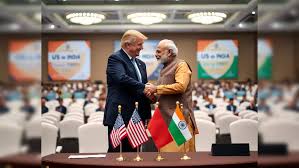Lagatar24 Desk
New Delhi: India is prepared to slash tariffs on more than half of American imports—valued at over $23 billion—as part of the initial phase of a proposed trade deal with the United States, according to a Reuters report citing senior Indian government officials. The move is aimed at averting retaliatory reciprocal tariffs planned by US President Donald Trump from April 2, which have stirred global market unease.
Currently, India’s trade-weighted average tariff stands at 12%, significantly higher than the US average of 2.2%, as per World Trade Organization data. The United States holds a trade deficit of $45.6 billion with India. Officials say the US tariffs could affect 87% of India’s $66 billion in exports, potentially disrupting major sectors such as pharmaceuticals and automobiles.
India’s Tariff Reduction Offer
India has offered to reduce or eliminate import duties on 55% of US goods currently taxed between 5% and 30%. This offer includes items such as electrical equipment, machinery, mineral fuels, and pearls—products that make up nearly half of India’s exports to the US.
An official stated that duties on items like almonds, pistachios, quinoa, and oatmeal could be cut, but tariffs on meat, maize, wheat, and dairy—ranging from 30% to 60%—will remain untouched due to domestic sensitivities.
India is also open to gradually reducing its steep tariffs on automobiles, which currently exceed 100%, though these changes may unfold over time.
Negotiation Timeline And Key Delegations
Trade discussions between the two nations gained momentum following Prime Minister Narendra Modi’s visit to the US in February. Both sides agreed to resolve long-standing tariff disputes and pursue a swift trade pact.
Brendan Lynch, Assistant US Trade Representative for South and Central Asia, is set to lead the American delegation in negotiations starting Tuesday in New Delhi. Indian officials emphasized that any tariff reduction will hinge on assurances of relief from reciprocal taxation by the US.
Alternative Strategy Under Consideration
While the Indian government remains open to across-the-board tariff reform, sources noted that negotiations may proceed on a sector-by-sector or item-specific basis rather than through a broad blanket reduction. This cautious approach allows India to safeguard sensitive sectors while promoting overall trade liberalisation.
Global Implications And Competitive Risks
With Trump labelling India a “tariff abuser” and threatening blanket tariffs, Indian exporters fear being edged out of the American market by competitors like Indonesia, Vietnam, and Israel—particularly in sectors such as pharmaceuticals and automobiles, which contribute $11 billion to India’s US-bound trade.
Indian policymakers aim to finalise a deal before April 2 to avoid major disruptions and preserve their competitive edge in global trade.







